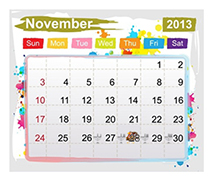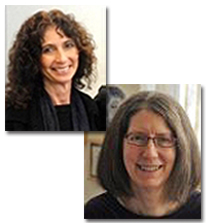Idie Benjamin and Dale Sides Cooperman
True story. A number of years ago, before we had heard of emergent curriculum or Reggio, the first night of Hanukkah was going to be the Sunday night after Thanksgiving. When November 1st arrived, a young teacher of three-year-olds, feeling it was her job to give children much information (which in her naïveté, she mistook for knowledge), offered a month of teaching on Thanksgiving. It was culturally sensitive, and there was a variety of appropriate, sensory-focused activities. She also offered a month of teaching on Hanukkah. It was carefully planned to include all curriculum areas and again, a variety of ways to explore the Hanukkah symbols and concepts was presented. It was a very busy month. On the Wednesday morning before Thanksgiving, one of the children walked up to the teacher. He snapped his fingers at her and said, “Hey, I got it. You take a turkey, you stuff it in a menorah, and you light it.” In that moment, the teacher realized that in her zeal to “cover the curriculum” and impart knowledge of what she believed to be essential themes of the month, she had successfully confused an entire class of children.
That epiphany was the beginning of this teacher’s journey which led her to consider curriculum and children very differently.
The yamin noraim, the High Holidays, with their unnervingly early dates are past. Just when we thought we could go back to normal, November looms large in the minds of teachers in Jewish early childhood schools. Thanksgiving and Hanukkah are on top of each other again. Didn’t we just write about this in August? “…There is tension and dread and a rising panic. It is coming and we won’t be ready or accomplish enough or make enough stuff. The children won’t know enough about it.”
And again we quote Rabbi Tarfun who should be the patron rabbi of all early educators: “It is not your responsibility to finish the work, but you are not free to desist from it either” (Pirkei Avot 2:16).
What does it mean to not have to “finish” the work but that we are not “free to desist from it either”? There is great wisdom here that should guide us always in our work. In this case, It tells us to thoughtfully examine the work we do and find that special place between overdoing and not respecting the capabilities of the children in our classes to engage meaningfully and deeply appropriate to their ages.
 Why do we think we have to do it all? If you didn’t have a month full of Thanksgiving activities, would that be so terrible? If the answer is yes, then you, the teacher, may be holding onto things that are important to you, but not necessarily meaningful to the children. This is an opening to gain a deeper understanding of how the child and not the teacher should be at the center of the experience. What is the essence of Thanksgiving and how can this be a part of the classroom for some small part of the month? What is this thing we have with all the turkey projects? What do children think when they find out what we really do to the turkeys? If you answered that turkeys are “cute,” remember that cute is a four-letter word that has no place in an early childhood classroom that is focused on meaning and intention.
Why do we think we have to do it all? If you didn’t have a month full of Thanksgiving activities, would that be so terrible? If the answer is yes, then you, the teacher, may be holding onto things that are important to you, but not necessarily meaningful to the children. This is an opening to gain a deeper understanding of how the child and not the teacher should be at the center of the experience. What is the essence of Thanksgiving and how can this be a part of the classroom for some small part of the month? What is this thing we have with all the turkey projects? What do children think when they find out what we really do to the turkeys? If you answered that turkeys are “cute,” remember that cute is a four-letter word that has no place in an early childhood classroom that is focused on meaning and intention.
And Hanukkah – What does getting ready for Hanukkah mean? We say that all the time. “We have to get ready for ….” whatever the next holiday is. We know what getting ready in a home means, but what does it mean in a classroom? Will there be a test? Is this a credentialing system with a required number of songs, stories, projects, and activities? There is a start date, but only a self-imposed ending day. We are so worried about having enough time to get to the holiday that we see it as the finish line. In reality, it is the beginning of the celebration. Does exploring what has engaged and provoked learning have to stop on ninth day? Turn curriculum on its head and acknowledge that time is not short this year; there is actually more of it with almost all of December to continue to explore and investigate. That brings our individual classrooms and individual children back into focus. We know so well that each class, year after year, is so different from others we have taught. Each group, each year, deserves its own unique year together with its teachers.
We need to get off the hamster wheel of planning. Debbie Silver, Idie’s friend and colleague, says, “Do less and do more with it.” Doing too much can, in the end, mean very little was learned as the young teacher in the story learned.
In our classrooms, it is not all the busy-ness that brings deep understanding and meaning. The core of our work, what makes it holy work, is the teacher’s personal connection with each child as a member of the sacred community we have created. This has far more significance than any cute art project.
This year’s calendar is not a crisis but an opportunity. It gives us the gift of making time for self-reflection. It asks the questions – am I an intentional teacher? How does this group learn? Where do their interests lie? What can these children learn from what we are doing? What is the next step in their learning?
This year’s calendar helps us to reflect, as we figuratively hold a mirror up to our own practice and the intention in our teaching. What do we see? Do we see an educator who sees children as strong and capable of directing their own learning? Or do we see the teacher who sets the agenda and controls the curriculum?
Think about our cautionary tale of the overzealous teacher.
Yes, November is coming, but it is going to be okay.


